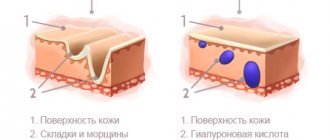How to restore a second youth and attractiveness to your vagina
A wide vestibule and stretched walls significantly impair the woman’s satisfaction and greatly reduce the man’s sensations. There are other situations when the partners’ genitals differ significantly in size. Such intimacy does not bring sexual satisfaction. To correct the discomfort that has arisen or prevent the possible, there is intimate vaginal plastic surgery - anterior, posterior or combined lifting.
Preparing for vaginoplasty
You need to prepare for vaginoplasty surgery. Take tests - extended hospital complex for surgery, do an ECG, smear for flora and oncocytology. If you have had a sexually transmitted infection, it must be treated. Consult a therapist. The day before surgery, do not eat much, especially bread. Food should be easily digestible. In the evening you need to do a microlax enema; one tube will be enough. In the morning, if you want, you can drink a little water (no more than 150 ml). When you are admitted to the hospital, you sign an informed agreement for surgery and anesthesia. If you have varicose veins of the lower extremities, be sure to take compression stockings with you.
What are the methods of vaginal plastic surgery?
Next, we will consider possible ways to solve the problem or information on how to make friends with your vagina again. Correction options can begin with non-surgical methods and only if they are ineffective, or immediately, according to indications, move on to invasive methods of tightening the vagina.
Vaginal plastic surgery
It is a surgical procedure or technique in which the internal and external muscles and structures around the vagina are reduced and tightened by the surgeon by removing excess tissue from the front and/or back walls to create the desired volume, shape and improve aesthetic appearance. The surgery helps restore muscle tone and improve vaginal muscle control and strength. Not only does it increase sexual pleasure during intimacy, but it can also provide relief from urinary incontinence symptoms.
Currently, in gynecology, there are several methods of intimate vaginal plastic surgery, which allow, in particular, after childbirth to reduce its volume and size:
- anterior vaginal plastic surgery,
- plastic surgery of the posterior vaginal wall,
- anterior-posterior vaginal surgery (combined colporrhaphy).
The choice of one method or another is based on the results of a preliminary study, which allows the intimate surgeon to assess the condition of the organ and develop an individual tactic for surgical treatment.
How is vaginal correction surgery performed?
In the Department of Operative Gynecology, plastic surgery is performed under general anesthesia and lasts from 1 to 1.5 hours. The patient sleeps throughout the entire process. When she wakes up in the observation room, she feels well and usually goes home within a few days. The recovery period takes about 3-4 weeks. To avoid complications, during this time you should not lift weights, ride a bicycle or engage in horseback riding, and you should especially monitor bowel movements, avoiding constipation. You shouldn't sit a lot, but you can lie down and walk as much as you like. Your doctor will give you detailed instructions.
After plastic surgery, all women are recommended to perform Kegel exercises to maintain long-term results and keep the vaginal walls toned.
Vaginal contouring
Using hyaluronic acid injections in our clinic, specialists perform non-surgical correction of the vaginal opening, moisturizing and increasing the tone of its muscles. The vestibular cuff is filled with gel injections. This procedure makes his vaginal opening narrower and significantly increases sensitivity.
The advantage of the procedure for intimate vaginal plastic surgery with filler is that it can be performed on an outpatient basis, local (application) anesthesia is used, and the recovery period takes only 3-4 days. At the same time, to enhance sexual sensations, you can enlarge the G-spot, correct the shape and size of the clitoris, and improve the condition of the skin of the perineum. The best alternative to vaginal reduction surgery!
Laser correction of the vagina
Another non-surgical option is laser. A beam of fractional laser radiation is used to heat soft tissue to a temperature of 60 to 70 degrees Celsius. According to equipment manufacturers, this increased heat causes neocollagenesis, which causes the vagina to become firmer and more elastic. This point of view is not shared by many representatives of the medical community, including us. Why? Just remember the school physics course for grades 8-9, which talks about the thermal effect on protein structures (and a person is made of them, and the female vagina is no exception) and the immediate and long-term adverse results of such an effect. The physical factor (radio wave, laser, radiation) is not of fundamental importance. Therefore, before deciding on this method of vaginal plastic surgery, you should think carefully!
Other techniques
The easiest option is to do Kegel exercises. They are performed by patients independently using visual aids or using special products. This combines efforts to hold your breath and consciously control the contractions of your pelvic floor muscles. This can be done anywhere and such exercises often produce wonderful results. In combination with training to tighten the walls and vaginal muscles, special treatment methods in gynecology (plasmolifting, massage of the pelvic organs, quantum therapy) will certainly be useful for the condition of the muscles of the pelvic organs and perineum. Their positive effects are: improving blood flow, eliminating lymph stagnation, increasing receptor activity and general tone of the urogenital area!
What do we get as a result?
- Increased friction during sexual intercourse;
- Improves control over vaginal tissues and perineal muscles;
- Increased sexual satisfaction;
- The cosmetic appearance of the intimate area is updated;
- The internal vaginal diameter decreases;
- Interest in sex is renewed and maintained;
- The pelvic floor is strengthened, which can help with urinary incontinence.
Price for vaginal plastic surgery
What can be done to correct the most important intimate area and how much does it cost?
| Services | Prices, ₽ |
| Posterior wall plastic surgery | 50 000 |
| Input correction (space) | 30 000 |
| Excision of septum 1 category. difficulty level 2 difficulties | 25 000 40 000 |
| Removal of cyst 1st category. difficulty level 2 difficulties | 25 000 40 000 |
| Complex vaginoplasty (levatoro-, perineoplasty), in the hospital from | 95 000 |
| Preparing for surgery | |
| Appointment with a specialist | 2 500 |
| Tests (smears, blood), approx. | 4 000 |
| Anesthesia test | 2 500 |
| Treatment before surgery | 1 000 |
| Local anesthesia, 1 unit. | 2 500 |
| Observation | 0 |
| Removing stitches | 0 |
Vaginoplasty after surgery
In the early postoperative period, the patient is kept in the ward for observation and receives antibacterial treatment. After 2 hours, urinary function is assessed, if everything is without difficulty, you can go home. At home, the treatment prescribed by the doctor, treatment of the wound, and compliance with the protective regime continue.
You are allowed to sit only sideways or on a special pillow. Diet excluding bread, using products that have a laxative effect on the intestines. Sexual rest for at least 2 months. You cannot visit the sauna, swimming pool, or fitness center for 2 months.
After 1 month you can sit without a special pillow. 2 months after surgery, the volume of the vaginal tube is assessed. Kegel exercises are prescribed with and without exercise machines. Complete rehabilitation of the vagina after surgery can take from 2 to 6 months. When a scar forms at the surgical site, special preparations and techniques are used to resolve it.
Why is the vagina no longer pleasing?
Despite the rich history of information about what modern plastic and reconstructive intimate surgery can do for women, it is clearly not enough. Perhaps this is why the resulting dissatisfaction of spouses with the quality of sexual intimacy disrupts the harmony of family relationships, often leading to their complete rupture. Features of vaginal architectonics can be either an individual characteristic given from birth or, more often, acquired with age or after pregnancy and childbirth. The birth of a child is undoubtedly a bright, unforgettable event in a woman’s life. It gives her the happiness of motherhood and makes the family complete. However, she herself suffers greatly.
Childbirth is a real test for the female body and, first of all, for the walls of the vagina. During the passage of a child through the birth canal, ruptures of not only the labia minora, vaginal walls, but also muscles are possible. These breaks can be minor or very deep. For deep tears, the obstetrician delivering the baby puts stitches. The doctor’s primary task at this moment is to eliminate the threat to the mother’s life associated with bleeding. There is often no time to think about tightening the vaginal wall and the aesthetic and functional consequences of birth injuries.
Later, rough connective tissue may form at the site of the sutures. The muscles in this anatomical zone begin to work less efficiently. As a result, the width of the vagina increases, and a gaping of the genital slit may occur, which in itself does not look very aesthetically pleasing. In cases where muscle damage is very deep, more unpleasant consequences may occur - prolapse of the vaginal walls, up to uterine prolapse, incontinence of gases and urine, pain during sexual intercourse. Sometimes postpartum anorgasmia (lack of orgasm) occurs. Remember that the vagina and surrounding tissues are made up of muscles and elastic tissues. As they age, they undergo many changes. This can lead to a change in a woman’s attitude towards sex and a deterioration in her urination (urinary incontinence in women 40+).
All of this can affect your overall health, both physical and emotional. This reduces a woman’s self-esteem, leads to a deterioration in psychological and physical well-being, and leaves an imprint on the mutual satisfaction of the spouses with the quality of their intimacy. These phenomena usually progress with age...
Therefore, when it comes to the quality of intimate life, there are no trifles! Vaginal plastic surgery in the clinic will correct the shortcomings of nature, improve the function and appearance of such a delicate area of the female body. Restoring the genitals and tightening the weakened walls of the vagina is a real task for a good specialist in intimate aesthetics.
Indications for vaginal correction
Ideal candidates for vaginoplasty are women who would benefit from such a lift, namely:
1. Who want not only a more youthful appearance, but also better performance of their vulvas and vaginas. 2. Girls and young women with weakened muscle tone of the intimate muscles. 3. Patients with vaginal dysfunction that is the result of aging, trauma, genetics, abortion or childbirth.
In the above cases, the tissues of the vaginal wall are stretched and therefore have less tone and strength and are poorly controlled during intimacy. Sexual experience will not bring the expected satisfaction not only to the woman herself, but also to her partner. To avoid possible negative consequences of vaginal laxity, it is advisable to see a plastic surgeon-gynecologist. Only a specialist in this field has the right to give a woman recommendations regarding the need for surgery to restore vaginal structures and reconstruct the pelvic floor muscles, or advise other methods of correcting the vagina.
Vaginoplasty before and after photos
Contraindications
Although fillers based on hyaluronic acid are completely safe and hypoallergenic, intimate contouring cannot be performed if:
- presence of cancer;
- pregnancy and lactation;
- bleeding disorders, such as hemophilia or when taking anticoagulants;
- the presence of acute infectious or inflammatory diseases, especially accompanied by an increase in body temperature;
- exacerbation of chronic diseases;
- tendency to form keloid scars;
- individual intolerance to filler components, including excipients.
Also, the procedure is not performed on girls under 18 years of age.
Shapes of the labia minora
There is no generally accepted standard for the size of the labia minora! It is generally accepted that, in the supine position, the labia should be visible, but without pronounced protrusion beyond the labia majora. It is believed that the “normal length” of the PGM from base to edge, from an aesthetic point of view, is 4 cm.
The patients themselves consider the labia to be elongated if they protrude beyond the labia majora. But this condition is not a pathology, it is a development option. From a medical point of view, hypertrophy, elongation and asymmetry of the labia minora are distinguished.
MPG hypertrophy
With hypertrophy, there is thickening of the walls, increased folding and elongation. The labia minora are enlarged evenly and symmetrically throughout.
MPG elongation
Elongation is lengthening without thickening; more often there is a lengthening of the middle part of the labia minora. Elongation can be congenital or acquired.
Reasons for MPG elongation
- Heredity;
- Prematurity (the labia majora do not cover the labia minora);
- Age-related atrophic changes;
- Traumatization (childbirth, horse riding, cycling, masturbation);
- Constitutional features (asthenic body type).
PGM asymmetry
Asymmetry of the labia minora can be congenital or acquired (trauma during childbirth, inflammatory changes, errors during plastic surgery). Asymmetry is considered to be both asymmetrical lengthening or shortening, as well as normal development of one labia and lengthening or underdevelopment of the opposite one. Asymmetry includes various types of post-traumatic deformities.
Traumatic deformity with the formation of a defect in the right lip
Back to contents
What do women desire?
• Ideal functionality (primarily high-quality sex, but not only) • Aesthetics and the absence of any defects • Not only visible, but also real youth (no sagging, drooping walls, etc.)
Vaginal plastic surgery is an aesthetic gynecological operation that should be entrusted only to a highly qualified specialist, such as, for example, the vice-president of the Russian Society of Aesthetic Gynecology, MD, Professor Svetlana Vyacheslavovna Gagarina.
We do not inflate prices and provide the highest level of surgery, medical care and service.
Methods for correcting the shape and size of the labia
The method of plastic correction for each specific case is determined during a consultative examination.
Marginal resection (amputation)
The most commonly used method is to remove the edge of the MG. This method is the least natural from an anatomical point of view. In essence, amputation of the labia minora is carried out over a significant extent. The anatomical, most elastic edge, in which the sensitive nerve endings are concentrated, is removed. Subsequently, this can adversely affect sexual sensations and disrupt the natural barrier between the vagina and the external environment.
Scheme
Photos before and after
Wedge resection (plasty)
The method comes from plastic surgery and involves removing excess mass by cutting out tissue in the shape of a triangle and then suturing the defect. The technique allows you to preserve the edges and normal anatomy of the MPG, and, accordingly, get rid of the disadvantages of resection.
Scheme
Photos before and after
With hypertrophy, a larger volume of tissue is removed and two triangles are cut out.
Scheme
Photos before and after
Back to contents











